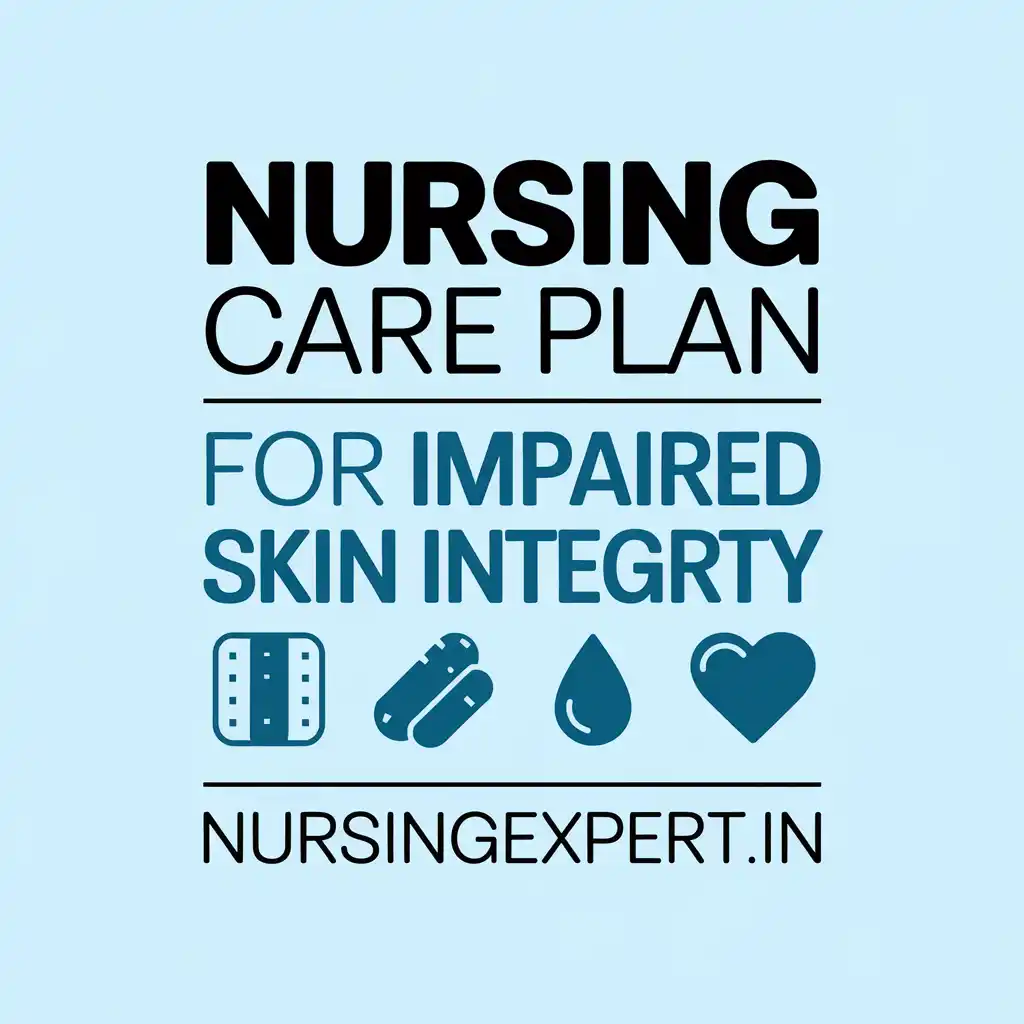Impaired skin integrity is a common nursing concern that can lead to infection, pain, and delayed healing. A structured nursing care plan for impaired skin integrity provides clear guidance for assessing skin condition, setting goals, and implementing targeted interventions. This comprehensive guide details the diagnosis, management, signs and symptoms, interventions, and etiology of impaired skin integrity. A downloadable PDF version is available for clinical practice and exam preparation.
Thank you for reading this post, don't forget to subscribe!
1. Introduction
Impaired skin integrity can result from pressure, trauma, or chronic conditions. Nurses use a nursing care plan for impaired skin integrity to assess the wound, set achievable goals, and apply targeted interventions that promote healing and prevent complications. This guide provides a step-by-step approach to managing skin injuries and supports evidence-based practice. A downloadable PDF version is available for quick reference during clinical practice and exam preparation.


2. Understanding Impaired Skin Integrity
Impaired skin integrity refers to any disruption of the skin’s normal structure or function. This condition may include pressure ulcers, lacerations, burns, or surgical wounds. Maintaining skin integrity is critical because the skin acts as a barrier against infection and fluid loss. A clear care plan ensures consistent evaluation and timely interventions.
3. Pathophysiology of Impaired Skin Integrity
Skin injuries occur when the skin’s protective barrier is compromised. Damage can result from external pressure, friction, or exposure to harmful substances. The body responds with inflammation, which may delay healing if the wound remains open. Reduced blood flow and moisture imbalance can further impede recovery. Understanding these processes helps nurses plan effective interventions to promote tissue repair.
4. Etiology of Impaired Skin Integrity
Several factors contribute to impaired skin integrity:
- Pressure and Friction: Prolonged pressure or friction from immobility leads to skin breakdown.
- Trauma: Cuts, burns, or surgical incisions can damage the skin.
- Chronic Conditions: Diabetes, vascular disease, and malnutrition hinder skin repair.
- Moisture Imbalance: Excess moisture from incontinence or wound exudate may cause maceration.
- Aging: Aging skin is thinner and more vulnerable to injury. Identifying these causes enables nurses to tailor the nursing care plan for impaired skin integrity to each patient.
5. Signs and Symptoms of Impaired Skin Integrity
Patients with impaired skin integrity may display:
- Redness or discoloration around the wound
- Open or blistered areas
- Swelling, pain, and tenderness
- Signs of infection, such as pus or foul odor
- Delayed wound healing
- Skin breakdown in pressure areas
Early recognition of these signs is crucial for prompt and effective intervention.
6. Nursing Diagnosis for Impaired Skin Integrity
Based on NANDA guidelines, common nursing diagnoses include:
- Impaired Skin Integrity related to pressure, trauma, or infection as evidenced by open wounds or ulcerations.
- Risk for Infection related to a compromised skin barrier.
- Acute Pain related to tissue damage and inflammation.
- Ineffective Health Management related to inadequate knowledge about wound care.
- Deficient Knowledge regarding proper skin care techniques. These diagnoses form the basis of an effective nursing care plan for impaired skin integrity.
7. Nursing Interventions for Impaired Skin Integrity
Nursing interventions focus on promoting wound healing, preventing infection, and reducing pain. Key interventions include:
- Wound Cleaning and Debridement:
Clean the wound with appropriate antiseptics and remove necrotic tissue as ordered.
Rationale: Cleaning reduces bacterial load and promotes healing. - Dressing and Moisture Management:
Apply suitable dressings to maintain a moist environment without causing maceration.
Rationale: Proper moisture balance supports tissue repair. - Pain Management:
Administer prescribed analgesics and use non-pharmacological methods such as cool compresses.
Rationale: Reducing pain improves patient comfort and facilitates care. - Infection Prevention:
Use aseptic technique during all wound care procedures and administer antibiotics if indicated.
Rationale: Preventing infection is vital for optimal healing. - Nutritional Support:
Collaborate with a dietitian to ensure a high-protein, nutrient-rich diet.
Rationale: Adequate nutrition is critical for tissue repair. - Pressure Relief Measures:
Implement repositioning strategies and use pressure-relieving devices for immobile patients.
Rationale: Reducing pressure helps prevent further skin breakdown. - Patient Education:
Teach patients about proper wound care, hygiene, and the importance of adhering to the care plan.
Rationale: Educated patients are more likely to participate in their own care.
8. Nursing Management Strategies
Effective management of impaired skin integrity involves a systematic approach:
- Initial Assessment:
Perform a comprehensive evaluation of the wound’s size, depth, and condition. - Ongoing Monitoring:
Regularly assess wound progress, vital signs, and pain levels. - Timely Interventions:
Initiate treatment immediately to prevent complications. - Patient Education:
Provide clear, practical instructions on wound care and prevention techniques. - Follow-Up Care:
Schedule regular check-ups to monitor healing and adjust interventions. - Interdisciplinary Collaboration:
Work with physicians, wound care specialists, dietitians, and pharmacists for a holistic approach.
This structured management plan supports effective healing and improves overall patient outcomes.
9. Patient and Family Education
Educating patients and families is essential for effective wound care:
- Understanding the Wound:
Explain the cause of impaired skin integrity and its impact on health. - Daily Care Routine:
Demonstrate proper cleaning, dressing changes, and use of pressure-relieving devices. - Medication and Nutritional Guidance:
Provide information on prescribed medications and dietary recommendations. - Signs of Infection:
Teach patients to recognize warning signs, such as increased redness, swelling, or discharge. - When to Seek Help:
Instruct on the importance of reporting any changes promptly. - Follow-Up Care:
Emphasize the need for regular medical evaluations. Clear education empowers patients and families to manage care effectively and enhances recovery.
10. Interdisciplinary Collaboration
A collaborative approach is key to managing impaired skin integrity. Nurses should work with:
- Physicians:
To assess wound status and adjust treatment plans. - Wound Care Specialists:
To provide advanced techniques for managing complex wounds. - Dietitians:
To create nutritional plans that support healing. - Pharmacists:
To ensure safe and effective medication use. - Patient Educators:
To reinforce self-care practices and proper wound care techniques. - Social Workers:
To assist families in accessing resources and support. This teamwork ensures comprehensive, patient-centered care.
11. Sample Nursing Care Plan for Impaired Skin Integrity
Below is a sample nursing care plan for impaired skin integrity. This plan breaks down the process into clear, actionable steps:
| Assessment | Nursing Diagnosis | Goal/Expected Outcome | Intervention/Planning | Implementation | Rationale | Evaluation |
|---|---|---|---|---|---|---|
| Subjective Data: – Patient reports pain and discomfort at a pressure ulcer site. Objective Data: – Red, swollen skin with partial-thickness loss; pain rated 7/10. | Impaired Skin Integrity related to pressure ulcer as evidenced by red, swollen skin and pain. | Short-Term: – Within 1 day, reduce pain and inflammation. Long-Term: – Wound heals with minimal scarring and no signs of infection. | Clean the wound with an antiseptic solution and apply appropriate dressings; administer analgesics as prescribed. | Follow aseptic technique during dressing changes; monitor pain every 30 minutes; document wound progress. | Cleaning and proper dressing reduce bacterial colonization and promote healing. | Pain decreases; wound appearance improves; signs of infection reduce. |
| Subjective Data: – Patient reports discomfort and difficulty moving due to a wound. Objective Data: – Limited mobility; wound near a bony prominence. | Risk for Impaired Tissue Integrity related to pressure and friction on vulnerable skin areas. | Short-Term: – Within 24 hours, patient uses assistive devices for repositioning. Long-Term: – Patient maintains optimal skin condition and avoids new pressure injuries. | Develop a repositioning schedule and provide pressure-relieving devices; educate patient on proper movement techniques. | Assist patient with regular repositioning; ensure proper use of pressure-relieving cushions; monitor skin condition during each shift. | Reducing pressure on vulnerable areas prevents further skin breakdown. | Skin condition stabilizes; new pressure ulcers are prevented; patient reports increased comfort. |
| Subjective Data: – Patient and family express uncertainty about wound care at home. Objective Data: – Inconsistent wound care practices; family asks for detailed instructions. | Deficient Knowledge regarding proper wound care as evidenced by inconsistent practices and family uncertainty. | Short-Term: – Within 24 hours, patient and family will verbalize key wound care techniques. Long-Term: – Family adheres to a consistent wound care routine and attends follow-up appointments. | Develop an education plan with clear, written instructions and visual aids on wound care management. | Conduct individual teaching sessions; provide brochures; schedule follow-up sessions to reinforce learning. | Education empowers patients and families to manage wound care effectively. | Family demonstrates understanding; adherence improves; follow-up confirms consistency. |
12. Downloadable Nursing Care Plan for Impaired Skin Integrity PDF Download
Nursing Care Plan for Impaired Skin Integrity PDF Download
Access our complete nursing care plan for impaired skin integrity PDF download. This comprehensive resource provides detailed, step-by-step instructions, NANDA-based nursing diagnoses, targeted interventions, and patient education strategies to manage skin injuries effectively. Use this document for clinical practice or exam preparation.
📥 Download Nursing Care Plan for Impaired Skin Integrity PDF
13. Frequently Asked Questions
Find answers to commonly asked questions about our products and services.
Still have a question?
If you have any other queries, feel free to reach out to us. Our knowledgeable team is here to help!
14. Conclusion
A structured nursing care plan for impaired skin integrity is vital for promoting wound healing and preventing complications. By conducting thorough assessments, implementing targeted interventions, and educating patients and families, nurses can significantly enhance skin recovery and overall patient outcomes.
15. References and Sources
- Mayo Clinic. (2023). Mobility and Rehabilitation. Retrieved from https://www.mayoclinic.org/healthy-lifestyle/fitness/in-depth/exercise/art-20045506
- MedlinePlus. (2023). Wound Care. Retrieved from https://medlineplus.gov/woundcare.html
- NANDA International. (2022). NANDA Nursing Diagnoses: Definitions and Classifications. Retrieved from https://www.nanda.org/
- American Burn Association. (2023). Burn and Wound Management Guidelines. Retrieved from https://ameriburn.org/
- Centers for Disease Control and Prevention (CDC). (2023). Pressure Ulcers: Prevention and Care. Retrieved from https://www.cdc.gov/pressureulcers


